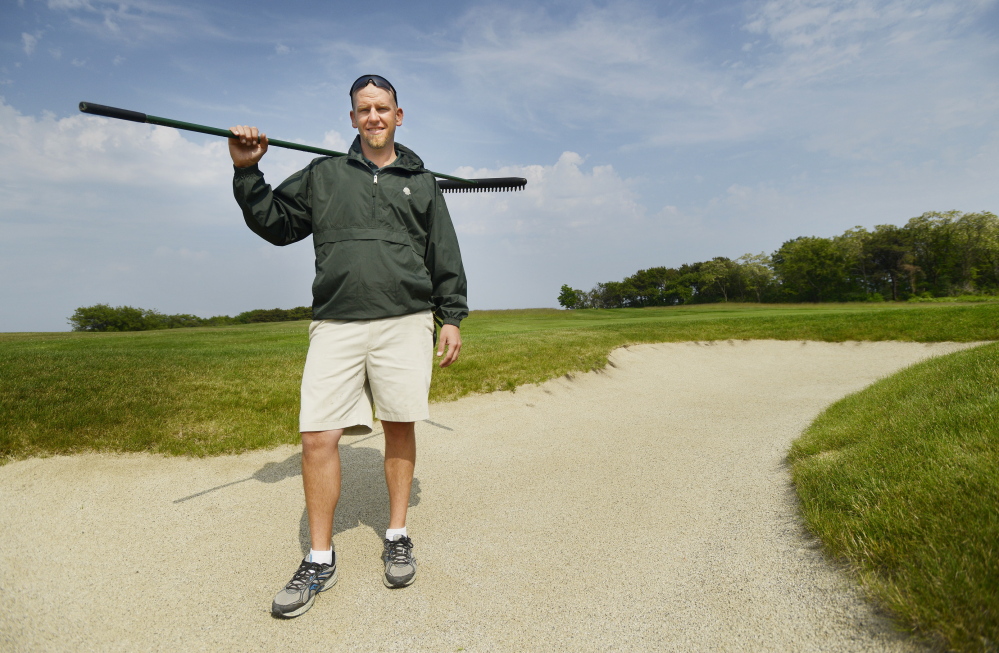Bob Searle watched from the left of the 18th green at Chambers Bay on Sunday as Dustin Johnson was about to enter golfing infamy.
Johnson needed a 12-foot, downhill eagle putt to win the U.S. Open; two putts would at least force a playoff with Jordan Spieth the next day.
“We were all hoping he would make the eagle putt so we could go home Monday,” Searle said.
Johnson did the unthinkable: He missed both putts, and Spieth won the championship in University Place, Washington.
Searle, the golf course superintendent at Abenakee Club in Biddeford Pool, had a prime view of the action because he was part of the volunteer grounds crew at the U.S. Open. His job each day was to roll the greens on 12th, 15th and 18th holes, along with the putting green.
“You roll the greens to make them smoother,” Searle said Tuesday.
Smoother also means faster.
The greens and the course were controversial topics during and after the tournament. Several players complained about the conditions of the greens, saying they were bumpy and inconsistent to putt on.
“What wasn’t playable were the green surfaces,” England’s Ian Poulter told reporters.
“If this was a regular PGA tour event, lots of players would have withdrawn and gone home on Wednesday, but players won’t do that for a major.”
Billy Horschel, the reigning FedEx Cup champion, did a mock tomahawk chop to a green after he missed a putt Sunday.
He later moved his hand in a wavy pattern to show that a putt didn’t keep its line.
“It’s just been a disappointing week with the way the greens are,” Horschel said afterward. “I hit a lot of really good putts that have bounced all over the world.”
Searle said he felt the players’ comments “were a little whiny. The U.S. Open is the toughest test in golf.
“I can understand their frustrations but it’s not supposed to be easy. Everyone was playing the same course. Everyone had an early and a late starting time.”
The greens at Chambers Bay consist of fine fescue. Poa annua, a type of grass common in the Northeast, was also a part of the greens.
“They were in transition with the fescue and the poa annua, and that caused the bumps,” Searle said.
“Poa is high maintenance. It requires a lot of water and a lot of fertilizer. It grows fast and comes out later in the day while fine fescue tends to lay down in the afternoon. Fine fescue is much more common in Europe. It needs a milder winter climate like in the Pacific Northwest to survive.”
Green surfaces and player gripes aside, Searle said the experience of working a U.S. Open was “the dream of a lifetime.
“I’ve always wanted to work a U.S. Open. I’ve tried to in the past. There are so many people who want to. My club was gracious enough to let me leave when we’re on the doorstep … of the golf season.”
Searle emailed the golf course superintendent at Chambers Bay, Josh Lewis, and asked if he could be part of the grounds crew. He was told his name would be put on a list. Searle learned that he was accepted last Christmas.
“You have to pay for your flight, but housing, transportation and meals are taken care of. They give you shirts and hats.”
Searle said there were 120 volunteers and he was the only one from Maine.
“Chambers Bay has a regular crew of 40, but they need a lot more to help during the Open because of the amount of work,” Searle said.
“We’re mowing fairways, greens, approaches and raking bunkers, and there are a lot of bunkers there, and everything needs to be done between 4 and 7:30 a.m.”
Searle, 29, graduated from Kennebunk High, where he played on the golf team. He graduated from Southern Maine Community College with a degree in business administration, then earned a certificate in agronomy from the University of Massachusetts Turfgrass School.
He has been the head superintendent at Abenakee – a private, nine-hole course – for three years and served an assistant for his father, Greg, prior to that. Greg Searle spent 27 years as course superintendent at Cape Arundel Golf Course in Kennebunkport before coming to Abenakee, where he is now the facilities manager.
“Bob used to go to work with me at Cape Arundel when he was a kid,” said Greg Searle.
At Chambers Bay, Searle felt he hit the jackpot with the 12th, 15th and 18th holes.
The 12th was the driveable par 4 that the players looked to hit out to the right to take advantage of the slope near the green and the carom. The 15th was a pivotal downhill par 3, and No. 18 was a hole played as a par 4 or 5, a first for a U.S. Open. On Sunday, it played as a par-5.
Searle had plenty of time to watch the action between his morning and evening shifts.
“There was a group of us watching on 18 directly across from the stands,” said Searle. “We had a great view of the green.”
Next year the U.S. Open will be played at Shinnecock Hills Golf Club on Long Island, New York, and Searle said he would like to be on the grounds crew again.
“I could drive to that one,” he said.
Send questions/comments to the editors.



Comments are no longer available on this story